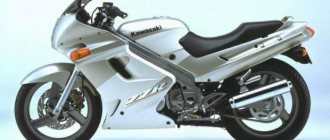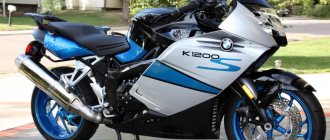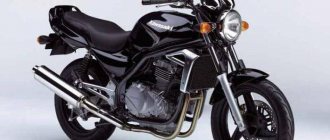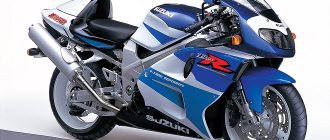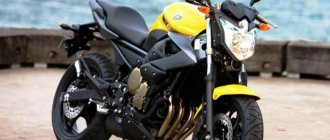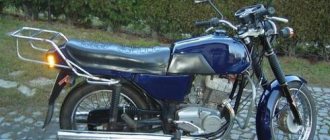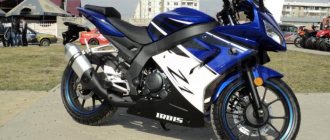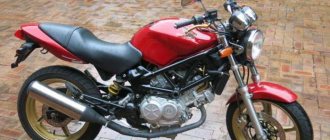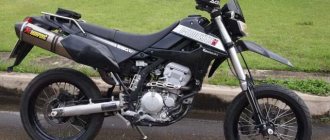The Kawasaki ZZR 250 motorcycle appeared back in 1990. This was a replacement for the outdated GPZ/GPX 250R models. Initially, the motorcycle was sold in Japan, Europe and North America. The model belongs to the “sport tourism” class. The article will give a short review of the Kawasaki ZZR 250 and provide reviews from the owners of this model. It should be immediately noted that this motorcycle has become a true legend of the Japanese motorcycle industry. But let’s not get ahead of ourselves and begin to understand the issue gradually.
Power unit
As the engine for the Kawasaki ZZR 250, the manufacturer chose a two-cylinder four-stroke engine, which was equipped with liquid cooling, with four valves for each cylinder. The working volume of the power unit was 248 cm³. The engine produced a respectable 40 horsepower (23 Nm of torque). Maximum engine performance can be obtained in the range of 9500-12,500 rpm.
It is noteworthy that Kawasaki motorcycles (among the leading motorcycle manufacturers in Japan) were the first to be equipped with simple and very reliable two-cylinder engines in small-capacity classes.
You can take a closer look at the approach of other Japanese companies to the creation of 250 cc motorcycles of the “sport” and “sport-touring” classes of that time. A motorcycle with an engine capacity of 400 cubic meters was taken as a basis, and then the engine’s displacement was reduced, and the running speed was slightly simplified. The end result was a motorcycle that was as close as possible to the track models, and its power was approximately 45 horsepower. These motorcycles were expensive for the manufacturer, and he was forced to inflate the market value of these motorcycles. At the same time, these models did not have much reliability and were characterized by a relatively short engine life (due to the incredible boost of the power unit, small engine volume and a large number of cylinders - more than two).
Kawasaki motorcycles were made differently. The ZZR 250 is a great example of this. The model turned out to be extremely successful, it was distinguished by its reliability and from the very start of sales it became in demand in all markets. The Kawasaki ZZR 250 was not finalized for a long time due to the fact that everything was good about it. The first modifications to this model date back to 2007. The manufacturer was forced to modify the model to bring it under updated environmental requirements. No other modifications were required throughout the entire production of the model! This says a lot.
Brief history of the model
- 1991 - start of production and sales of the Kawasaki ZR250 Balius model. First generation. At Japanese auctions it is designated as Balius-I. The motorcycle produces 45 hp. power and 25.49 Nm of torque. Colors: black, purple, red.
Model:
Kawasaki Balius 250 (Japan).
Frame number:
ZR250A-000001 to ZR250A-016000.
Factory designation:
ZR250-A1.
- 1992 - no significant changes. Colors: blue, red, black.
Model:
Kawasaki Balius 250 (Japan).
Frame number:
ZR250A-016001 to ZR250A-035000.
Factory designation:
ZR250-A2.
- 1993 - with the release of changes in Japanese legislation, the maximum power of the motorcycle decreased to 40 hp, torque - to 23.53 Nm. Colors: black, red, purple.
Model:
Kawasaki Balius 250 (Japan).
Frame number:
ZR250A-035001 to ZR250A-055000.
Factory designation:
ZR250-A3.
- 1994 - no significant changes. Colors: black, red, purple.
Model:
Kawasaki Balius 250 (Japan).
Frame number:
ZR250A-055001 to ZR250A-062000.
Factory designation:
ZR250-A4.
- 1995 - no significant changes. Colors: black, red, silver.
Model:
Kawasaki Balius 250 (Japan).
Frame number:
ZR250A-062001 to ZR250A-075000.
Factory designation:
ZR250-A5.
- 1996 - no significant changes. Colors: white-cherry.
Model:
Kawasaki Balius 250 (Japan).
Frame number:
ZR250A-075001 -.
Factory designation:
ZR250-A6.
- 1997 - Second generation. At Japanese auctions it is designated as Balius-II. The main difference from the first generation is a double shock absorber at the rear (instead of a monoshock absorber). The carburetors receive throttle sensors (K-TRIC). Colors: black, black with red tail, silver.
Model:
Kawasaki Balius 250 (Japan).
Frame number:
ZR250B-000001 to ZR250B-007000.
Factory designation:
ZR250-B1, ZR250-B1A.
- 1998 - no significant changes. Colors: red, silver.
Model:
Kawasaki Balius 250 (Japan).
Frame number:
ZR250B-007001 to ZR250B-014000.
Factory designation:
ZR250-B2.
- 1999 - model not produced.
- 2000 - the model receives a new exhaust, maximum speed is reduced to 17,000 rpm. Colors: yellow, blue, white.
Model:
Kawasaki Balius 250 (Japan).
Frame number:
ZR250B-014001 to ZR250B-017000.
Factory designation:
ZR250-B4.
- 2001 - the model receives a new engine (the cylinder diameter and piston stroke are changed). Maximum power - 39.5 hp. at 14,000 rpm, maximum torque - 20.59 Nm at 13,000 rpm. Colors: same as previous year.
Model:
Kawasaki Balius 250 (Japan).
Frame number:
ZR250B-017001 to ZR250B-021000.
Factory designation:
ZR250-B5.
- 2002 - no significant changes. Colors: blue, white, black.
Model:
Kawasaki Balius 250 (Japan).
Frame number:
ZR250B-021001 to ZR250B-025000.
Factory designation:
ZR250-B6.
- 2003 - The fuel tank capacity is reduced to 14 l (instead of 15 l). Colors: black, red, silver.
Model:
Kawasaki Balius 250 (Japan).
Frame number:
ZR250B-025001 to ZR250B-028000.
Factory designation:
ZR250-B7.
- 2004 - no significant changes. Colors: black, silver, blue.
Model:
Kawasaki Balius 250 (Japan).
Frame number:
ZR250B-028001 to ZR250B-032000.
Factory designation:
ZR250-B8.
- 2005 - no significant changes. Colors: same as previous year.
Model:
Kawasaki Balius 250 (Japan).
Frame number:
ZR250B-032001 to ZR250B-035000.
Factory designation:
ZR250-B9.
- 2006 - no significant changes. Colours: black, silver, dark grey.
Model:
Kawasaki Balius 250 (Japan).
Frame number:
ZR250B-035001 to ZR250B-038000.
Factory designation:
ZR250-B6F.
- 2007 is the last year of production. No significant changes. Colors: black, red, blue.
Model:
Kawasaki Balius 250 (Japan).
Frame number:
ZR250B-038001 to ZR250B-040XXX.
Factory designation:
ZR250-B7F.
Revolution
The ZZR 250 made a lot of noise back in its day. In fact, he had no worthy competitors in the class. managed to create a successful model. The bike was very popular with customers. It is very strange that other manufacturers (especially Japanese) for a long time did not undertake to create a worthy competitor for this motorcycle model. This passivity of competitors, of course, was to their advantage.
But it would be more interesting for the buyer to choose from several manufacturers rather than buy the uncontested ZZR 250, although there were no complaints about it at all from ordinary motorcyclists. This motorcycle was ahead of its time!
Motorcycle suspension
One of the special features of the Kawasaki ZZR 250 is its lightweight aluminum frame (the first versions of the motorcycle had a steel frame, but after 1992 it was replaced with an aluminum frame). The motorcycle suspension itself is extremely simple, it consists of a conventional telescopic fork, as well as a progressive Uni-Trak monoshock absorber (has a five-stage preload adjustment). The model has disc brakes (single-piston caliper at the rear, four-piston caliper at the front). The suspension does not have any nuances or “blunders”. It can be described as very simple and extremely reliable. The steering wheel is small, like almost all motorcycles in the class, but the bike’s handling is excellent.
Bike appearance
The design of the motorcycle is in the classic Japanese sports spirit. The model is characterized by smooth lines and shapes. There is a certain aggressiveness in the appearance of the motorcycle. Also striking is the factory colorful color scheme of the model. Although from the first glance at the motorcycle it becomes clear that this is a model from the “sport-tourism” class. It must be said that the bike looks stylish and aggressive, in no small part due to its specific alloy wheels. It is worth noting that in the first releases of the model the wheels were more interesting than those of later models. But perhaps this is just a matter of taste.
Kawasaki ZZR 250: technical specifications
Let's repeat about the engine: the engine has a displacement of 248 cm³. The two-cylinder four-stroke engine has a power of 40 horsepower (23 Nm of torque). The transmission is a six-speed manual gearbox. Chain drive. The weight of the motorcycle is 146 kilograms. The maximum speed of the Kawasaki ZZR 250 is 160 km/h. Acceleration to the first hundred is 6 seconds. The fuel tank volume is 18 liters (on updated models released after 2000, the tank volume decreased and amounted to 17 liters), and the dry weight of the motorcycle “grew” by two kilograms.
Specifications
The parameters of the Kawasaki ZZR 250 corresponded to its purpose and, within the approximately 30 years that it was produced, made it quite competitive. Both the transmission, the chassis, the engine, and the brakes fully cope with the tasks assigned to them.
Engine
Uncharacteristic for bikes of this type, the engine here is two-cylinder. Moreover, it is in-line and four-stroke. The unit is liquid cooled. Its working volume is 248 cm³. There are four valves per cylinder. The updated version has the following maximum characteristics: at 9000 rpm, the torque is 22 Nm; at 12500 rpm the power reaches 40 hp.
The maximum speed of the model is 160 km/h, while it accelerates to 100 km/h in approximately 6 seconds. The motorcycle has electronic ignition. The compression ratio in the engine is 12.4:1. The fuel supply system is carburetor.
Transmission
Both the original version of the Kawasaki ZZR 250 and the updated gearbox have the same transmission. The chain acts as a drive. The gearbox is six-speed. This transmission is quite sufficient for a motorcycle with such capabilities.
Dimensions and weight
The weight of the bike without fuel is 146 kg, while the curb weight reaches 160 kg. The gas tank volume is 18 liters, which, frankly speaking, is average for a sports touring motorcycle. Fuel consumption per 100 km of road varies from 3.17 to 4.9 liters.
So, if you try to drive as economically as possible, you can travel almost half a thousand kilometers without refueling. The rear tire dimensions are 140/70-17, while the front tire size is 100/80-17.
Chassis and brakes
At first the frame was diagonal steel, but in 1992 it was decided to replace it with another, also diagonal, but aluminum. This is more consistent with a sports motorcycle. The design is in a sporty spirit: smooth shapes, aggressive appearance, colorful colors. However, at first glance it is clear that this is a sports touring bike.
As befits such models, the steering wheel is small. At the same time, it is very comfortable, and driving the car is easy, even at maximum speeds. The motorcycle looks stylish, in no small part thanks to the specific alloy wheels, which were especially good on the first generation version.
The swingarm rear suspension with Uni-Trak monoshock provides five-stage preload adjustment. At the front, the suspension is provided by a telescopic fork with dimensions of 37 mm. The rear brakes are equipped with a single 193 mm disc with a single-piston caliper. At the front, there is also one disc that acts as a brake, but it is 276 mm in size, and the caliper here is four-piston.
Production
The motorcycle was produced for a very long time - until 2008, when it was replaced by the Ninja 250 R. For three decades, the Kawasaki ZZR 250 successfully competed in the market, since there were very few such non-standard sports touring bikes during the period of its production. For a while, there was simply no one to compete with him.
Classmates
Among the rivals of this model, there is perhaps only one motorcycle - the GSX 250 F Across from Suzuki. In some ways it is superior to the Kawasaki bike, in others it is inferior to it, but overall they are on par in terms of their characteristics and design, which is very similar.
End of the ZZR era
Nothing can last forever. The Kawasaki ZZR 250 replaced outdated models and eventually became outdated itself. The last copy of this motorcycle was released in 2007. And a year later, the manufacturing company presented customers with the successor to this model; it became the Kawasaki Ninja 250R.
It is worth noting that there are still plenty of ZZR 250 motorcycles on the secondary market. It is quite possible to find a motorcycle in very decent technical condition for a relatively moderate amount. Buyers choose this model on the secondary market for its incredible reliability; in addition, spare parts for the Kawasaki ZZR 250 are inexpensive and are almost always either in stock or quickly delivered by specialized stores. The motorcycle is not a problem.
Kawasaki ZZR 250: reviews
The owners of this motorcycle are happy people. At least, this conclusion can be drawn by analyzing reviews of this motorcycle. The model is almost indestructible. The most important rule, according to the owners, is competent, timely maintenance of the motorcycle, as well as the use of high-quality spare parts and technical fluids.
Sometimes you can come across a review that says that this motorcycle lacks power. This is not entirely true; most likely, this review is left by a person who has already “outgrown” the 250 cc class and the time has come for him to consider a more powerful and voluminous motorcycle. For its engine size, the ZZR 250 is very decent.
Reviews
Reviews about Kawasaki Balius:
Expand Collapse
As a noob, I had enough stupidity. Even in these 250 cubes. At least I didn’t let the Sibihams down :) I’m a café racer myself. Or whatever it is. Well, actually, I don’t like to drive :) I’d prefer to come as one of the last ones, I’m in no hurry. Bali was playful until one day he blew my mind with an electrician. Well, I didn’t know that I should have checked the starter right away. Noobism. Afterwards I had a story with a dead engine temperature sensor, which I fixed by turning on the passive cooling from the toggle switch. Having repaired this very interesting element in an equally interesting way, as described earlier, the exciting season continued.
Now the pros and cons:
+Chic dynamics for 250cc. Amazing for a beginner.
+ Straight steering wheel, not clip-ons.
+Low saddle height (a critical factor for me)
-Uncomfortable saddle for the second number (she constantly slipped)
- Eats like a small car. 6 liters exactly. After all, 18 thousand. But I didn’t turn it to this point 
-No fuel level indicator (although a full tank is enough for 230 km)
And so for a beginner - just right 
Economical
The fuel consumption officially declared by the manufacturer for the Kawasaki ZZR 250 is 3.2-4.9 liters of gasoline for every hundred kilometers. This is in theory, in practice it comes out to about 4.5-6.0 liters per hundred kilometers (average). But the exact fuel consumption value always depends on your riding style, the quality of gasoline and the health of your motorcycle. In any case, the motorcycle is not too power-hungry, but it cannot be called an economical bike either; in this regard, everything is usual, without surprises (pleasant or unpleasant).
It should be noted that the bike is quite loyal to Russian fuel. This is very important because some motorcycle models are very sensitive to poor quality fuel, and all this can lead to serious problems with the bike’s fuel system, but with the ZZR 250 there will be no such problems.
Prices
A used ZZR 250 can be bought today for 2-2.5 thousand dollars, if you consider options from abroad and without mileage in Russia. If you look at the options on our market, they start at 80 thousand rubles. As practice shows, models that do not have mileage in Russia are in better technical condition and last longer, and therefore do not cause the owner absolutely any trouble. But everyone chooses a model according to their goals and financial capabilities.
When buying a motorcycle, pay attention to its technical condition, so as not to spend half the motorcycle season (which in Russia is not very long anyway) on eliminating all the flaws left by the previous owner. In any case, we repeat, spare parts are not too expensive, and the structure of the motorcycle is quite simple, that is, it is possible to repair the bike yourself, without contacting specialized services, provided that you have sufficient technical knowledge, the necessary tools and relevant experience.
Test drive KawasakiZZR 250
The small-capacity sports tourer Kawasaki ZZR250 was released in 1990. The Japanese took the well-proven in-line two-cylinder engine from the Kawasaki Eliminator 250 chopper, boosted it to forty horsepower and installed it in a steel diagonal frame, despite the fact that the “big brother” Kawasaki ZZR 400 had long sported an aluminum one. The notorious Japanese “practical economy” did not affect, it seemed, only the plastic body kit. The design of the motorcycle in those distant nineties, although it was moderately aggressive, was still ahead of its time by a decade - it still looks quite modern, especially against the backdrop of the Japanese “second-hand” of one thousand nine hundred “... 1919”. Gradually, competitors left this class, moving to larger weight categories, and Kawasaki was left to reign supreme in this niche alone. But, as life shows, the victory of one species over another significantly slows down its evolution, and the 2002 ZZR 250 that came into my field of vision was no exception - it was not very different from the 1990 model.
Still the same “two hundred and fifty”, still the same silhouette, still the same in-line two... But enough criticism, the motorcycle is produced to this day, enjoying enviable popularity both among beginners and people with experience, having proven its reliability and reliability over the years of its existence. ease of use.
Despite its cubic capacity, the motorcycle does not look small. With my height of 180 cm, it is quite comfortable to sit on it, which is facilitated by a full-fledged comfortable seat. The handlebar clips are in the right place and not too low, so your hands are not overloaded. The windshield is quite large, its angle and dimensions make it immediately clear that this is a sports tourer. The brake and clutch release mechanisms are equipped with adjustments, like those of their adult “brothers,” and this is very nice - everyone can customize the “steering wheel” to suit themselves. My model already has a hazard warning button installed. The steering wheel itself has good turnout, which gives the ZZR250 a serious advantage in maneuverability. If you have to push around in a city crowd, it will fully demonstrate that quality that motorcycles of this class so lack - agility in dense city traffic. Large mirrors will also help in this situation, which on this motorcycle are quite functional and fit well into the overall silhouette, in harmony with the large headlight and pseudo-air intakes of “inertial charging”.
Under the beautiful plastic “wrapper” lies a four-stroke, two-cylinder, in-line engine with four valves per cylinder, liquid cooling, and a volume of 248 cm3. A fuel tank of substantial capacity (18 liters) can allow you to travel about 500 km without refueling! Yes, this is not a typo, on the Kyiv-Kharkov-Kyiv route the average consumption of 92 gasoline was 3.5 liters per “hundred”. Theoretically, its fuel efficiency is such that the Kawasaki ZZR250 can cover a distance of 40 kilometers on one liter of gasoline!
At 12,500 rpm, the engine produces quite a respectable power of 40 hp. Torque peaks at 10,000 rpm and is 24 Nm. The gearbox is six-speed. The main drive is chain, and the chain is “adult”, 520th.
The front brake disc (276 mm) is quite capable of making stoppies, and when paired with the rear disc (193 mm), the motorcycle stops dead in its tracks.
Japanese engineers did not skimp on the wheels - the “250” has 17” wheels, the front tire is 100/80 R17, and the rear tire is 140/70 R17. The chrome-plated muffler banks are also beautiful, and you can’t say that this is a “two hundred and fifty” model. This whole miracle weighs neither more nor less: 146 kg.
The test drive of the ZZR250 turned out to be accidental and unplanned, but it became a real test, both for the motorcycle and for me personally. It so happened that I urgently needed to visit the city of Kharkov, but there were no tickets “for now” (as always!) at the box office. Time was running out, and without further ado, I decided to give up on Kawasaki. What's the point of going here - less than 500 km! I left in the afternoon, around three o'clock. I thought that I would make it before the rain (clouds were just gathering on the horizon). Like, I’ll kill you with a bullet... I wandered through city traffic jams for an hour, and by four I left the outskirts of the city. Moving around the capital pleased me: despite the very busy streets, I drove freely from traffic light to traffic light - sometimes along the side of the road, and sometimes between the rows of cars. The bike is very narrow and can fit into any cracks, however, an in-line two is not a four...
It’s pleasant to maneuver at low speeds, the motorcycle steers miraculously easily - after all, it weighs “almost nothing.” In the mirrors you can see not only my elbows, but also two lanes of traffic, which makes it easy to build a trajectory. The headlight shines brightly, and the cars, seeing me at the unloaded areas, run away to the curb... It’s nice, damn it! The instrument panel is easy to read - a classic of the genre... A good large tachometer with a large red scale is located almost in the center and next to it is a smaller speedometer. The neutral lamp glows brightly. And the gearbox gives no reason to scold it: the foot moves very easily and all gears are engaged clearly, even neutral. Plus the practical use of brakes: Kawasaki has respect and respect - this “baby” saved me, and not even twice.
I would like to take this opportunity to say hello to the blonde girl with lipstick in her hand in a red Mazda 6! I expected your maneuver, so I was not indignant. Next - to the driver of the Bogdan route: your trick was unexpected and led me into slight confusion, followed by a stoppage. I apologize for the profanity and the attempt to take you out of the minibus... And the hit of the whole trip around Kyiv: a guy in a silver Lanos who overtook me on the side of the road. Yes, that’s right, I won’t lie: I almost jumped out of my seat from fright. It seemed to me that I was driving in the far right lane, but the speedometer was about “one hundred”...
That's it, I'm leaving Kyiv. The motorcycle picks up speed very well, the acceleration dynamics are quite decent. The engine spins up from the bottom and picks up speed smoothly. Now the needle passes the cherished “hundred”, one hundred twenty, one hundred and forty... it slows down at one hundred and sixty and smoothly approaches oh, and very reluctantly gets to one hundred and seventy-five... That’s it, my curiosity is satisfied, and I slow down. Driving the “one hundred and seventy” is completely uncomfortable. The wind protection is, of course, good, no doubt about it, but the noise is such that it can only be withstood in a race. Although, perhaps this is a feature of my helmet. If you take the “embryo” position, completely hidden behind the glass, the noise is significantly reduced. I remember the great teachers and stick to the speed recommended by the manufacturer: 110-120 km/h... Comfortable. Mirrors play their role, and here they perfectly protect the shoulders from the wind flow. In the city we sometimes had to adjust them: on our potholes a couple of times they went off course.
Having a light weight, the motorcycle, oddly enough, handles the highway like a small sports bike. I exchanged two hundred kilometers of travel and did not notice how quickly they flew by. It started to rain... Suddenly I remembered about gasoline - the Zizer doesn’t run on the Holy Spirit! I stopped at the first gas station, opened the tank flap, and there was more than half of the gasoline in place... It happens! I drank some hot tea, topped up the tank until it was full, and drove on, already in the rain. In the rain the motorcycle is quite predictable, you can ride. An interesting feature of wind protection: when it rains, drops of water seem to fly past me... Not all of them, of course, but many. At night I reached the destination city, and there was “sawed-off” asphalt everywhere and there were no streetlights. The suspension helped out a lot: it never broke. The headlight snatches a wide section of the road out of the darkness and you can move confidently.
I rode around the city all morning and all day and didn’t regret for a minute that I took this motorcycle, because mobility in the modern world is strength. The bike successfully copes with the “conditional off-road” conditions of the Kharkov asphalt “hell”. It seems that the condition of the roads here is not even second on the list of urgent matters for city officials.
It was drizzling with light rain all the way back. The highway dried out and then got wet again. My joyful mood was spoiled from time to time by the feeling of my own insignificance when I received an air “poke” from the truck. After that, not without apprehension, you look at every long piece of equipment you meet... I increase my speed, I’d rather go home.
Still, at the end of the trip, the overalls got wet, and the ride no longer brought that puppy joy that so drove me “there.” In general, I got there without incident - the whole way back the Kava engine purred pleasantly, pleasing me with fuel consumption and comfort. Yes, this is not a big sport-tourist, swallowing hundreds of kilometers along with tens of liters of gasoline, but still there is something about it that allows it to be so popular.
It is suitable for people who love to travel, as well as city dwellers for everyday driving to, from and work. It will not leave indifferent those who like to “pop” and go through turns “with a knee”...
Reliable and practical (all spare parts for this Kawasaki are not a problem), the Zizer forgives many piloting mistakes and serves as a good platform for beginners. And gasoline prices and traffic jams on the streets force many people to switch to motorcycles. A completely adequate motorcycle, and, it seems to me, even without competitors or analogues...
Text: Ivan Borsch
Photo: michel
Bottom line
Who is the Kawasaki 250 suitable for? It is suitable as a first motorcycle or as a bike for every day. You won’t be able to take part in extreme high-speed racing on it (but the 250 cc motorcycle class is not for that at all). This is a faithful friend for measured trips on high-quality surfaces for reasonable money. On such a motorcycle it is quite possible to go on a long trip. It won't be very comfortable, but it can be worse. Perhaps this was the benchmark among Japanese motorcycles in its class in its time and for this money.
Many motorcycle enthusiasts say that they bought this model as a first bike for one or two seasons, but continued to ride it for five or more seasons. This motorcycle is too alive, and there is something about it that sinks into the very heart. Ultimately, motorcyclists still sold this bike, reluctantly and buying a more powerful model. But some motorcyclists left it in their garages just in case and bought an additional, more powerful motorcycle.
If we talk about this motorcycle as an option for beginners, then the Kawasaki ZZR 250 is best suited for this role. With this bike you will experience the whole range of necessary sensations: you will feel the wind, the road, drive, adrenaline and speed. The model is suitable for learning all basic driving techniques, while the driver is guaranteed a feeling of pleasure from all this. You will really like the motorcycle, and it will be able to quickly adapt to your riding style and your habits. With it you will quickly gain the necessary riding experience.
The Kawasaki ZZR 250 will definitely go down in world history. In the entire history of motorcycle creation, there are very few models that can successfully exist for thirty years without any serious technical modifications. This is one of those few bikes that can safely be called unique of its kind!
I warn you right away. This will be more about how I bought my motorcycle, and less about the Kawasaki ZZR-250 itself. I’ll make a video review about Kava itself a little later. For now, just a story about what it is like to buy a motorcycle at a Japanese auction, using my personal example. Welcome under cat. We've all had that moment when we decided to get on our own bike. It will come to someone else (there are such people here, I know) But first, you need to buy this bike. Whoever has the money to buy a new motorcycle is a lucky person. I went to the salon, paid, sat down and drove off - no problems! If you don’t have as much money as you want, you can open Auto.ru and find a second-hand motorcycle in your own city and its surroundings. And this is where the questions begin. How to buy a motorbike in good condition? How to diagnose it? Especially if you don’t understand anything about motorcycles yet, and somehow you haven’t found any friends who are motorcycle mechanics. I don’t think it’s worth buying at random, having heard enough from the former owner (or outbid?) about the delights of his device. It’s a dangerous thing, something will fly off later at speed and amen, instantly the sea, as they say, “instantly in the sea,” that is. There are different options, one of them is to simply buy a motorcycle from a Japanese auction. And it’s really simple, although there are nuances.
This will be more about how I bought my motorcycle, and less about the Kawasaki ZZR-250 itself. I’ll make a video review about Kava itself a little later. For now, just a story about what it is like to buy a motorcycle at a Japanese auction, using my personal example. Welcome under cat. We've all had that moment when we decided to get on our own bike. It will come to someone else (there are such people here, I know) But first, you need to buy this bike. Whoever has the money to buy a new motorcycle is a lucky person. I went to the salon, paid, sat down and drove off - no problems! If you don’t have as much money as you want, you can open Auto.ru and find a second-hand motorcycle in your own city and its surroundings. And this is where the questions begin. How to buy a motorbike in good condition? How to diagnose it? Especially if you don’t understand anything about motorcycles yet, and somehow you haven’t found any friends who are motorcycle mechanics. I don’t think it’s worth buying at random, having heard enough from the former owner (or outbid?) about the delights of his device. It’s a dangerous thing, something will fly off later at speed and amen, instantly the sea, as they say, “instantly in the sea,” that is. There are different options, one of them is to simply buy a motorcycle from a Japanese auction. And it’s really simple, although there are nuances.
So what do we get from this? a) Real Japanese quality (well, you know, right ). Seriously, you can buy not only Japanese there, but also Europeans. The condition of these motorcycles will be much better than those already used in Russia. b) At each auction there is a group of experts who set an auction estimate for the motorcycle. Please note, independent auction evaluation ! For the engine and transmission, appearance and frame. The resulting, final assessment, as an average, will determine the actual price of the motorcycle. There are also additional, written (read individual for each device) comments. In addition, there are a bunch of photos of the motorcycle itself and its individual parts. As a result, the buyer has a very clear idea of what he is bargaining for and in what technical condition it is! c) Choice! There really is a huge selection there! For example, the popular motorcycle for beginners, the Honda CB 400 (in different modifications), is traded at almost a dozen units a day (of different years, conditions, colors, etc.). And auctions take place almost every day. So, there is definitely a chance to choose what you need.
a) Real Japanese quality (well, you know, right ). Seriously, you can buy not only Japanese there, but also Europeans. The condition of these motorcycles will be much better than those already used in Russia. b) At each auction there is a group of experts who set an auction estimate for the motorcycle. Please note, independent auction evaluation ! For the engine and transmission, appearance and frame. The resulting, final assessment, as an average, will determine the actual price of the motorcycle. There are also additional, written (read individual for each device) comments. In addition, there are a bunch of photos of the motorcycle itself and its individual parts. As a result, the buyer has a very clear idea of what he is bargaining for and in what technical condition it is! c) Choice! There really is a huge selection there! For example, the popular motorcycle for beginners, the Honda CB 400 (in different modifications), is traded at almost a dozen units a day (of different years, conditions, colors, etc.). And auctions take place almost every day. So, there is definitely a chance to choose what you need.
What do we have in the negative? a) We must wait. The auction itself depends on your luck, but it is unlikely that you will win in the first auction. Unless the rate is deliberately inflated. For example, it took me a little over a month. Plus, for at least another month from the date of purchase, the motorcycle will reach you. b) There is a possibility that the bike will be damaged during transportation. In theory, first the intermediary is responsible for this, then the transport company. But all the same, these are unnecessary problems and troubles. c) And finally, it may happen that the intermediary will simply scam you out of money. After all, almost all actions are performed on mutual trust. Here you just need to choose a normal intermediary and everything will be fine 
Now the actual process itself. Having decided to take this step, I went online in search of an intermediary. Almost immediately I came across Sempermoto and decided that I would buy through them, which I never regretted in the future. The services are inexpensive, 5,000 rubles. This is for assistance in choosing, assistance in translating experts’ comments, playing at the auction at your rates, processing customs documents and PTS, and finally transferring the vehicle to a transport company (TP) for further transportation. It was harder to decide on the budget and model of my first motorcycle. Even then I understood that it was the first, therefore it should not be expensive, not powerful, not heavy, but convenient and suitable for me. Simplicity in design was welcomed. Choppers and healthy tourists were no longer needed - they are heavy, and it’s not my thing at all. Endurics are more for off-road, it seems to me, but all my trips are on asphalt. Sport for a beginner is generally a dubious choice, except perhaps straight to bed. That’s why road workers remain and... this strange class of sport-tourist represented by the Kawasaki ZZR-250 (in fact, nothing in common with either one). Everyone knows the Kawa Ninja, and the ZZR-250 is its progenitor. It looks like a sport, but the landing is more vertical, the shock absorbers are much softer, the fork rotates at a larger angle, and the engine is not so crazy, although it can still produce 40 horses per 12.5 revolutions. In the end, I settled on the Zizer 250 (four hundred is too big for me, although it costs about the same money).
I checked the statistics of sales of this moto at auctions, made sure that I fit well into the budget for a moto in normal condition (not lower than 4) and contacted the intermediary. Having announced the budget (up to 120 thousand rubles including all expenses) and having received the go-ahead, I sent the initial 30 thousand deposits. From that moment on, the most interesting part began - searching and bidding for lots of interest at Japanese auctions. The intermediary's website provides access to up to four auctions selling motorcycles: BDS, Arai, JBA and Aucnet. As my practice has shown, one largest BDS is quite enough, but 4 is still better than 1. Auctions take place almost every working day, so the process was quite intense. The day before the start of bidding, I looked at the lots I was interested in, decided on the maximum bid and sent it to the intermediary. The bidding step is 2000 yen, so there is a chance to buy the device for less money than the maximum bid. So day after day passed, but for some reason the money was not bought. After all, the age of 20-10 years, even in Japan, affects the technical condition and there were few devices with a normal honest rating of 4, and the bargaining for them was tight. So a month passed, and I began to send the intermediary several bets a day, not only on Zizer but even on some Sibikhs. But after the May holidays, suddenly my cell phone rings... they congratulate me on buying a mote! I receive an auction card for my motorcycle: I’m going to pay the remaining money to the bank. And from this day on, the longest and most uninteresting part of the buying process begins - waiting. Transportation by sea from Japan, customs clearance, dispatch by a freight company and travel through almost the whole of Russia. For everything, about everything, about a month. When loaded onto a ship in Japan, upon arrival in the Russian Federation and when sent by a transport company, you receive a dozen photos of the motorcycle. This is in Japan
Having announced the budget (up to 120 thousand rubles including all expenses) and having received the go-ahead, I sent the initial 30 thousand deposits. From that moment on, the most interesting part began - searching and bidding for lots of interest at Japanese auctions. The intermediary's website provides access to up to four auctions selling motorcycles: BDS, Arai, JBA and Aucnet. As my practice has shown, one largest BDS is quite enough, but 4 is still better than 1. Auctions take place almost every working day, so the process was quite intense. The day before the start of bidding, I looked at the lots I was interested in, decided on the maximum bid and sent it to the intermediary. The bidding step is 2000 yen, so there is a chance to buy the device for less money than the maximum bid. So day after day passed, but for some reason the money was not bought. After all, the age of 20-10 years, even in Japan, affects the technical condition and there were few devices with a normal honest rating of 4, and the bargaining for them was tight. So a month passed, and I began to send the intermediary several bets a day, not only on Zizer but even on some Sibikhs. But after the May holidays, suddenly my cell phone rings... they congratulate me on buying a mote! I receive an auction card for my motorcycle: I’m going to pay the remaining money to the bank. And from this day on, the longest and most uninteresting part of the buying process begins - waiting. Transportation by sea from Japan, customs clearance, dispatch by a freight company and travel through almost the whole of Russia. For everything, about everything, about a month. When loaded onto a ship in Japan, upon arrival in the Russian Federation and when sent by a transport company, you receive a dozen photos of the motorcycle. This is in Japan
And this is already in Vladik
Upon arrival, the vehicle goes through customs, documents are issued for it, and through an intermediary it ends up with the cargo company that you choose yourself (for example, I sent it through Vector-plus). The motorcycle is placed in a crate, all sorts of liquids that still remain are drained and loaded into a railway carriage. Moreover, what liquids remain in your motorcycle greatly depends on which cargo company it will be sent to. Everyone understands the instructions in their own way, so in the best case the device will arrive with a dry tank, in the worst case there will be nothing in it (at least that’s what they write on the forums, but I had everything except gasoline. I was lucky, on the 4th On the 18th, my motorcycle was handed over to the transport company, and on the 18th it was already in Moscow! A call from TP, and... I’m at its warehouse: Komsomolskaya, Yaroslavsky railway station
The motorcycle is placed in a crate, all sorts of liquids that still remain are drained and loaded into a railway carriage. Moreover, what liquids remain in your motorcycle greatly depends on which cargo company it will be sent to. Everyone understands the instructions in their own way, so in the best case the device will arrive with a dry tank, in the worst case there will be nothing in it (at least that’s what they write on the forums, but I had everything except gasoline. I was lucky, on the 4th On the 18th, my motorcycle was handed over to the transport company, and on the 18th it was already in Moscow! A call from TP, and... I’m at its warehouse: Komsomolskaya, Yaroslavsky railway station
Amazingly, after a month of travel over a distance of almost 10 thousand kilometers, the motorcycle only became slightly dusty! Just wipe with a cloth. A specially trained person removes the pallet from the warehouse.
Just wipe with a cloth. A specially trained person removes the pallet from the warehouse.
That's all! Knock down the sheathing boards and roll wherever you want! In a good way, you should remember to take a crowbar and a nail puller with you, but I managed with my hands, there are only about a hundred nails))
You can take a bottle of gasoline with you and leave on your own, but I used the services of motorized transportation and a cheerful guy in a Chinese van with Krasnodar license plates drove me home for 1,500 wooden ones.
The motor, as expected, is in excellent condition, despite its 1999 release. I changed the fluids and brake pads - haven't touched anything else yet. Everything is done simply and easier than by car. I haven’t gone to the service center yet, there doesn’t seem to be any need. The purchase budget ultimately did not exceed 100 thousand rubles, including the purchase of consumables. A little later, I’ll do a review of Kava itself, but for now that’s all!
